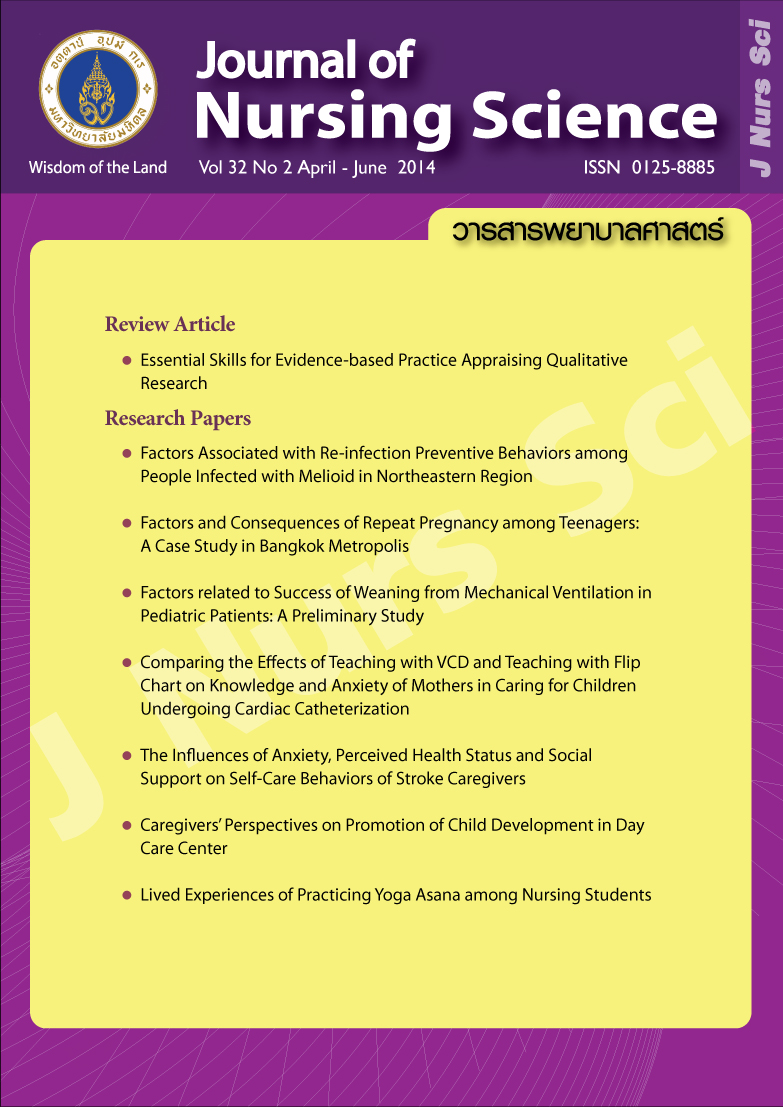Factors Associated with Re-infection Preventive Behaviors among People Infected with Melioid in Northeastern Region
Main Article Content
Abstract
Purpose: This research aims to investigate the relationship between knowledge of melioid, perceived susceptibility, perceived severity, perceived benefits, perceived barriers, and accessibility to melioid prevention resources, social support and re-infection preventive behaviors among people infected with melioid.
Design: A descriptive correlational study.
Methods: The sample was 109 melioid infected patients receiving treatment or follow up for the treatment at a melioid clinic. Data were collected using interview form and analyzed using descriptive statistics, Pearson’s product moment correlation coefficient, and Spearman’s rank correlation coefficient.
Main findings: Melioid re-infection preventive behaviors of the sample (91.8%) were at moderate level. Perceived susceptibility and perceived benefits were positively associated with melioid re-infection preventive behaviors (r = .25, p < .01; r = .24, p < .05 respectively). Perceived barriers was negatively associated with melioid re-infection preventive behaviors (r = - .40, p < .01). Others factors were associated with melioid re-infection preventive behaviors without any statistical significance.
Conclusion and recommendations: Melioid infected patients should be helped to enhance their perceived susceptibility and perceived benefits of preventive behaviors. Nurses and other healthcare personnels should work collaboratively with patients and their family in exploring how to decrease perceived barriers.
Keywords: melioid, preventive behavior, re-infection
ปัจจัยที่มีความสัมพันธ์กับพฤติกรรมป้องกันการติดเชื้อซ้ำของผู้ติดเชื้อเมลิออยด์ในภาคตะวันออกเฉียงเหนือ
บทคัดย่อ
วัตถุประสงค์: เพื่อศึกษาความสัมพันธ์ระหว่างความรู้เกี่ยวกับโรค การรับรู้โอกาสเสี่ยงต่อการเกิดโรค การรับรู้ความรุนแรงของโรค การรับรู้ประโยชน์ในการปฏิบัติพฤติกรรมป้องกันโรค การรับรู้อุปสรรคในการปฏิบัติพฤติกรรมป้องกันโรค การเข้าถึงทรัพยากรในการป้องกันโรค และแรงสนับสนุนทางสังคม กับพฤติกรรมป้องกันการติดเชื้อซ้ำของผู้ติดเชื้อเมลิออยด์
รูปแบบการวิจัย: การศึกษาความสัมพันธ์เชิงพรรณนา
วิธีดำเนินการวิจัย: กลุ่มตัวอย่างเป็นผู้ติดเชื้อเมลิออยด์จำนวน 109 คน ที่มารับบริการรักษาและมาตรวจตามนัดที่คลินิกโรคเมลิออยด์แห่งหนึ่ง เก็บรวบรวมข้อมูลโดยใช้แบบสัมภาษณ์และวิเคราะห์ข้อมูลด้วยสถิติเชิงพรรณนาและสัมประสิทธิ์สหสัมพันธ์แบบเพียร์สันและสเปียร์แมน
ผลการวิจัย: พฤติกรรมป้องกันการติดเชื้อซ้ำของผู้ติดเชื้อเมลิออย์ดส่วนใหญ่ (ร้อยละ 91.8) ออยู่ในระดับปานกลาง การรับรู้โอกาสเสี่ยงต่อการเกิดโรคและการรับรู้ประโยชน์ในการปฏิบัติพฤติกรรมป้องกันโรค มีความสัมพันธ์ทางบวกกับพฤติกรรมป้องกันการติดเชื้อซ้ำของผู้ติดเชื้อเมลิออยด์ (r = .25, p < .01; r = .24, p < .05) ตามลำดับ การรับรู้อุปสรรคในการปฏิบัติพฤติกรรมป้องกันโรค มีความสัมพันธ์ทางลบกับพฤติกรรมป้องกันการติดเชื้อซ้ำของผู้ติดเชื้อเมลิออยด์ (r = - .40, p < .01) ส่วนปัจจัยด้านอื่นมีความสัมพันธ์กับพฤติกรรมป้องกันการติดเชื้อซ้ำของผู้ติดเชื้อเมลิออยด์อย่างไม่มีนัยสำคัญทางสถิติ
สรุปและข้อเสนอแนะ: ควรส่งเสริมให้ผู้ป่วยเกิดการรับรู้โอกาสเสี่ยงต่อการเกิดโรค และรับรู้ประโยชน์ในการปฏิบัติพฤติกรรมป้องกันโรค นอกจากนั้นพยาบาลและบุคลากรสุขภาพอื่นควรร่วมมือกับผู้ป่วยและครอบครัวในการหาแนวทางช่วยลดอุปสรรคในการปฏิบัติพฤติกรรมป้องกันโรค
คำสำคัญ: เมลิออยด์ พฤติกรรมป้องกันโรค การติดเชื้อซ้ำ
Article Details
Copyright Notice: Nursing Science Journal of Thailand has exclusive rights to publish and distribute the manuscript and all contents therein. Without the journal’s permission, the dissemination of the manuscript in another journal or online, and the reproduction of the manuscript for non-educational purpose are prohibited.

Disclaimer: The opinion expressed and figures provided in this journal, NSJT, are the sole responsibility of the authors. The editorial board bears no responsibility in this regard.


